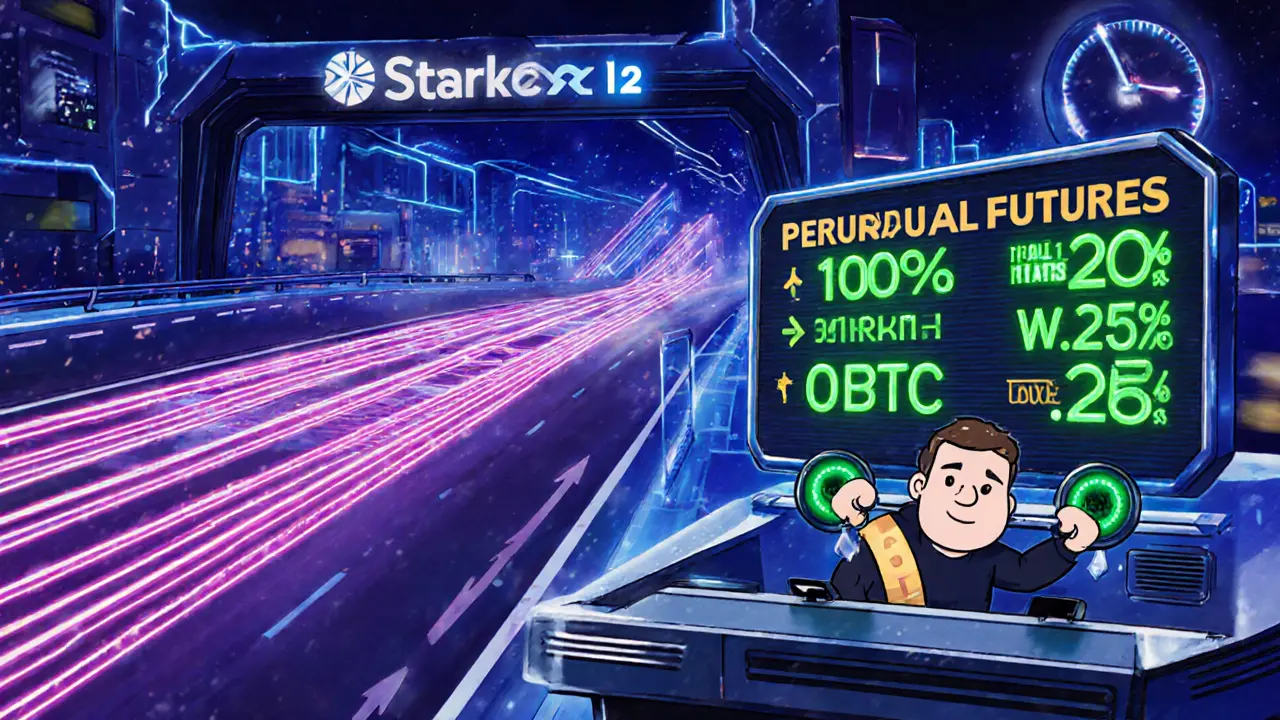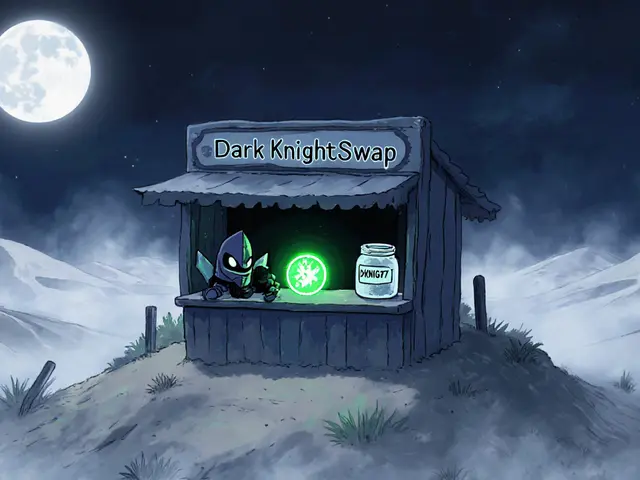Leverage Calculator
Apex Protocol Leverage Calculator
Calculate your potential profit or loss based on Apex Protocol's leverage options and fee structure.
Important Note: This calculator uses Apex Protocol's current fee structure (0.02% maker, 0.05% taker) and shows potential outcomes based on the data entered. Actual results may vary due to market volatility, network fees, and other factors.
When you hear the name Apex Protocol, you probably picture a sleek, centralized‑exchange‑style platform that still lets you keep control of your private keys. Launched in late 2021, this decentralized exchange (DEX) focuses on perpetual futures, spot swaps, and a non‑custodial model built on Ethereum and several EVM‑compatible chains. In this review we’ll walk through its core features, performance numbers, fee structure, tokenomics, security track record, and how it stacks up against rivals like dYdX and Hyperliquid.
Key Takeaways
- Provides a TradingView‑integrated order‑book UI that feels like a CeX while staying fully non‑custodial.
- Offers up to 1:20 leverage on 15 perpetual contracts, with maker/taker fees of 0.02%/0.05%.
- Processes ~9,000 tx/s on StarkEx L2, settling trades in under a second.
- APEX token has a fixed 25 M supply; 77% allocated to incentives and ecosystem growth.
- Main drawbacks: limited asset selection, no spot‑trading beyond perpetuals (until 2026), and basic email‑only support.
What is Apex Protocol?
Apex Protocol is a decentralized exchange that combines a centralized‑exchange‑style order book with non‑custodial wallet integration. The platform launched its mainnet in Q4 2021 and currently runs version Apex Pro 2.3 (released August 15 2025). It operates on a layer‑2 solution powered by StarkEx, allowing high throughput and low latency.
Core Features
- Perpetual Futures: 15 contracts covering ETH, WBTC, iZi and other major assets, with leverage up to 1:20.
- Spot Swaps: Limited to the same set of assets; full spot market slated for Q1 2026.
- Cross‑Chain Support: Deposits/withdrawals on Ethereum, Arbitrum, and Optimism; average bridge time ~4.2 minutes.
- Charting & UI: Integrated TradingView charts with a traditional order‑book layout, praised by 78 % of advanced traders in a CoinDesk survey.
- Wallet Integration: MetaMask, Rabby, Ledger Live and other EVM‑compatible wallets connect via a simple “Connect Wallet” button.
Performance & Fees
Independent benchmarking (CryptoCompare, Aug 2025) shows Apex Protocol handling roughly 9,000 transactions per second on StarkEx, with an average settlement time of 0.8 seconds. Daily trading volume hit $850 million in September 2025, placing the platform third in the DEX perpetual segment.
Fee schedule is straightforward: makers pay 0.02 % and takers 0.05 %. There are no hidden maker rebates, and the platform imposes no minimum deposit, making it accessible for newcomers.

APEX Tokenomics
APEX token serves both governance and utility roles. The token supply is capped at 25 million, with 23 % allocated to the founding team and early investors (locked for at least 12 months). The remaining 77 % fuels liquidity mining, staking rewards, and ecosystem grants. Token holders can vote on protocol upgrades, such as the upcoming spot‑trading module.
Security & Audits
The smart‑contract suite has undergone three public audits by OpenZeppelin (2021, 2022, 2024), each reporting no critical vulnerabilities. While StarkEx’s zk‑rollup design introduces a trusted‑setup component-raising centralization concerns among some analysts-the platform has never suffered a user‑fund hack.
Regulatory compliance remains limited; Apex Protocol lacks Tier‑1 licenses, which may hinder expansion into EU markets under MiCA. Nonetheless, its non‑custodial nature sidesteps many AML/KYC mandates that centralized exchanges must meet.
User Experience & Community
New users typically place their first trade within 15 minutes, according to WhalePortal usability tests. Advanced features (grid bots, complex order types) require roughly three hours of learning. Community support runs through Discord (≈42 k members) and Telegram (≈28.5 k members), with average response times of 8 hours for technical queries.
Feedback on Trustpilot (4.3 / 5 stars) highlights low fees and clean UI, while criticism targets limited asset breadth and slow email support (average 72‑hour reply).
How Apex Protocol Stacks Up
| Metric | Apex Protocol | dYdX | Hyperliquid | Perpetual Protocol |
|---|---|---|---|---|
| UI Satisfaction (out of 10) | 8.7 | 7.9 | 8.2 | 7.5 |
| Perpetual Pairs | 15 | 28 | 22 | 12 |
| Max Leverage | 1:20 | 1:10 | 1:25 | 1:15 |
| Maker Fee | 0.02 % | 0.03 % | 0.025 % | 0.04 % |
| Taker Fee | 0.05 % | 0.07 % | 0.06 % | 0.08 % |
| Daily Volume (Sept 2025) | $850 M | $2.1 B | $1.5 B | $620 M |
The table makes it clear: Apex Protocol shines in UI ease‑of‑use and fee competitiveness, but it trails behind dYdX and Hyperliquid in asset variety and raw volume.

Pros & Cons
- Pros:
- Intuitive, TradingView‑based UI.
- Low maker/taker fees.
- Fast settlement via StarkEx.
- Full control of private keys.
- Active community and frequent upgrades.
- Cons:
- Only 15 perpetual pairs - limited diversification.
- No spot trading until 2026.
- Email‑only support can be slow.
- StarkEx trusted‑setup raises centralization questions.
- Regulatory uncertainty in EU and US markets.
Roadmap & Future Outlook
The upcoming version 2.4, scheduled for Q4 2025, will integrate Chainlink’s Cross‑Chain Interoperability Protocol (CCIP), improving bridge security. Q1 2026 promises spot‑trading launch, while Q2 2026 aims to expand perpetual listings to over 30 pairs. If these milestones hit, Apex could close the asset‑gap with larger DEXs and attract more institutional flow.
Token‑price forecasts vary: CoinLore projects APEX at $2.68 by Dec 2025, whereas CryptoQuant suggests a more conservative $1.85. Much depends on whether the platform can secure regulatory clarity and broaden its market reach.
Verdict
For traders who value a fast, low‑fee interface and want to keep custody of their funds, Apex Protocol delivers a compelling experience that feels like a centralized exchange. However, serious portfolio diversifiers may find the limited asset roster restrictive until the promised spot module arrives. In the current DEX landscape, Apex sits comfortably as a “mid‑tier” player-strong on usability, still catching up on breadth.
Frequently Asked Questions
What chains does Apex Protocol support?
Apex runs on Ethereum, Arbitrum, and Optimism, allowing deposits and withdrawals across all three via its StarkEx layer‑2.
How much leverage can I use on Apex?
The platform offers up to 1:20 leverage on its 15 perpetual contracts.
Is Apex Protocol safe?
It has passed three OpenZeppelin audits with no critical issues, and its non‑custodial design means you control your private keys. The StarkEx rollup does involve a trusted‑setup, which some auditors flag as a minor centralization risk.
What are the trading fees?
Maker fees are 0.02 % and taker fees are 0.05 %, with no hidden charges.
When will spot trading be available?
The roadmap lists spot‑trading rollout for Q1 2026, subject to successful governance voting.









Jenna Em
October 21, 2025 AT 08:22Apex’s sleek UI makes you feel like you’re trading on a giant’s desk, yet the keys stay in your pocket. It’s a strange dance between trust and control that many never notice. The layer‑2 magic hides a lot of invisible code, and I wonder who really pulls the strings. If the rollup ever falters, the whole system could crumble without warning. We should keep an eye on the hidden governance tweaks.
Stephen Rees
October 21, 2025 AT 11:09Even though the interface looks friendly, the underlying math is anything but simple. The modest fee structure masks the cost of the trusted‑setup that underpins StarkEx. A user can trade comfortably today, but future upgrades might shift power toward the founders. It’s wise to stay modest in exposure until the roadmap proves itself.
Katheline Coleman
October 21, 2025 AT 13:55In evaluating Apex Protocol, one must first acknowledge its commendable effort to blend centralized‑exchange ergonomics with decentralized custody. The TradingView‑integrated order book undeniably lowers the barrier for traders accustomed to traditional platforms. Moreover, the sub‑second settlement on StarkEx presents a tangible improvement over many L2 competitors, which often experience latency in the order of several seconds. The fee schedule-0.02 % maker and 0.05 % taker-remains competitive, especially when contrasted with the higher rates observed on dYdX and Hyperliquid. However, the limited selection of fifteen perpetual contracts constrains portfolio diversification, a factor that cannot be overlooked by institutional participants. The absence of spot trading until 2026 further narrows the appeal for users seeking comprehensive market exposure. From a security perspective, the trio of OpenZeppelin audits, while reassuring, do not eliminate concerns surrounding StarkEx’s trusted‑setup, which introduces a degree of centralization that purists may find unsettling. Regulatory considerations also loom large; the lack of Tier‑1 licensing may impede expansion into jurisdictions with stringent MiCA requirements. The tokenomics, featuring a 25 million supply with 77 % allocated to incentives, provide ample room for liquidity mining but also raise questions about long‑term value capture for token holders. Community engagement appears robust, given the active Discord and Telegram channels, yet the reported 8‑hour response time for technical queries suggests room for improvement in support infrastructure. User onboarding, as measured by a 15‑minute first‑trade benchmark, indicates a user‑friendly experience, though mastery of advanced features still demands a significant learning curve. Looking ahead, the planned integration of Chainlink’s CCIP in version 2.4 could ameliorate bridge security concerns, and the forthcoming spot module promises to address current asset‑breadth shortcomings. It is essential for potential users to weigh the immediate benefits of speed and cost against the longer‑term uncertainties surrounding governance, regulation, and product expansion. Prospective investors should therefore monitor both technical upgrades and regulatory developments closely. In sum, Apex offers a solid intermediate solution for traders prioritizing speed and low fees, yet it remains a work in progress on several critical fronts.
Amy Kember
October 21, 2025 AT 16:42Apex’s UI is clean and the fees are low. It gets the job done for casual traders. The limited asset list is a drawback.
Evan Holmes
October 21, 2025 AT 19:29Sounds decent.
Isabelle Filion
October 21, 2025 AT 22:15One cannot help but admire the audacity of branding a L2 rollup as “decentralized” while sprinkling a handful of perpetuals like garnish. The UI shines, yet the ambition remains embarrassingly narrow, a boutique boutique of sorts. Clearly, the developers aim for elegance over substance, which, in the grand scheme, is a commendable trade‑off for those who enjoy aesthetic over depth.
Patrick Day
October 22, 2025 AT 01:02They say the smart contracts are audited, but who’s watching the auditors? Every time a new upgrade drops, there’s a silent patch that could open a backdoor. Stay skeptical, because the next “upgrade” might just be the one that empties wallets.
Ryan Comers
October 22, 2025 AT 03:49Wow, Apex thinks it can out‑run the big dogs with a measly 15 pairs! 🤦♂️ Let’s be real – if you want real liquidity, you go to dYdX or Hyperliquid, not some flashy UI on a side‑chain. 🇺🇸 Our market deserves more than a half‑baked prototype that will probably crumble under real volume.
Prerna Sahrawat
October 22, 2025 AT 06:35When one examines the architectural choices of Apex Protocol, the first impression is that of a meticulously crafted façade, a veneer of modernity draped over what is essentially a modest trading engine. The decision to employ StarkEx, while commendable for its throughput, introduces a level of opacity that the average trader may never comprehend. Their promise of sub‑second settlements is tantalizing, yet the underlying infrastructure remains susceptible to the same centralization criticisms levied at any zk‑rollup with a trusted setup. Moreover, the tokenomics appear to be a double‑edged sword: a generous 77 % allocation to incentives fuels liquidity, but it also risks inflating the token’s utility beyond its intrinsic value. The gap between the announced roadmap and actual delivery cannot be ignored; past delays have shown a pattern of overpromising and underdelivering. In contrast, competitors such as dYdX have steadily expanded their asset repertoire, providing traders with a broader canvas for diversification. The limited fifteen perpetual contracts on Apex feel like a curated gallery in a museum where the most popular works are missing. Spot trading’s promised debut in 2026 is a distant beacon that may never materialize if regulatory headwinds intensify. Regulatory ambiguity, especially concerning MiCA compliance, casts a shadow over any future expansion into European markets. Community support, though active in numbers, suffers from sluggish email responses, betraying a lack of priority for user concerns. Nevertheless, for those enamored with a sleek UI and willing to tolerate the constraints, Apex offers a niche experience that could serve as a stepping stone toward more expansive platforms. Ultimately, the question remains: is the allure of elegance sufficient to outweigh the practical limitations inherent in its design?
Joy Garcia
October 22, 2025 AT 09:22The hype around Apex feels like glitter on a cheap costume – flashy but ultimately shallow. While the UI dazzles, the underlying asset scarcity leaves traders thirsting for more. Patience will be key as the promised spot market drifts further into the horizon.
mike ballard
October 22, 2025 AT 12:09Apex leverages a StarkEx L2 to achieve sub‑second finality, which aligns with the industry’s push for high‑frequency on‑chain execution. The maker‑taker spread is ultra‑tight, facilitating cost‑efficient arbitrage strategies across EVM‑compatible chains. However, the current market‑depth constraints limit the efficacy of liquidation bots and cross‑margin positions. 😊
Tom Glynn
October 22, 2025 AT 14:55Think of Apex as a stepping stone on the path to decentralized mastery; each trade teaches resilience. The low fees act as a gentle reminder that the protocol values sustainable growth. Keep your risk modest, and let the platform’s speed work for you. Remember, consistency beats occasional bursts of leverage. Stay curious and enjoy the journey! 🚀
Anna Kammerer
October 22, 2025 AT 17:42Sure, the UI is pretty, but beauty doesn’t pay the bills when the asset list is a skimpy snack. If you’re looking for depth, you’ll need to hop over to a platform with a richer market set. Meanwhile, Apex can serve as a training ground for newcomers who appreciate low fees and a slick interface.